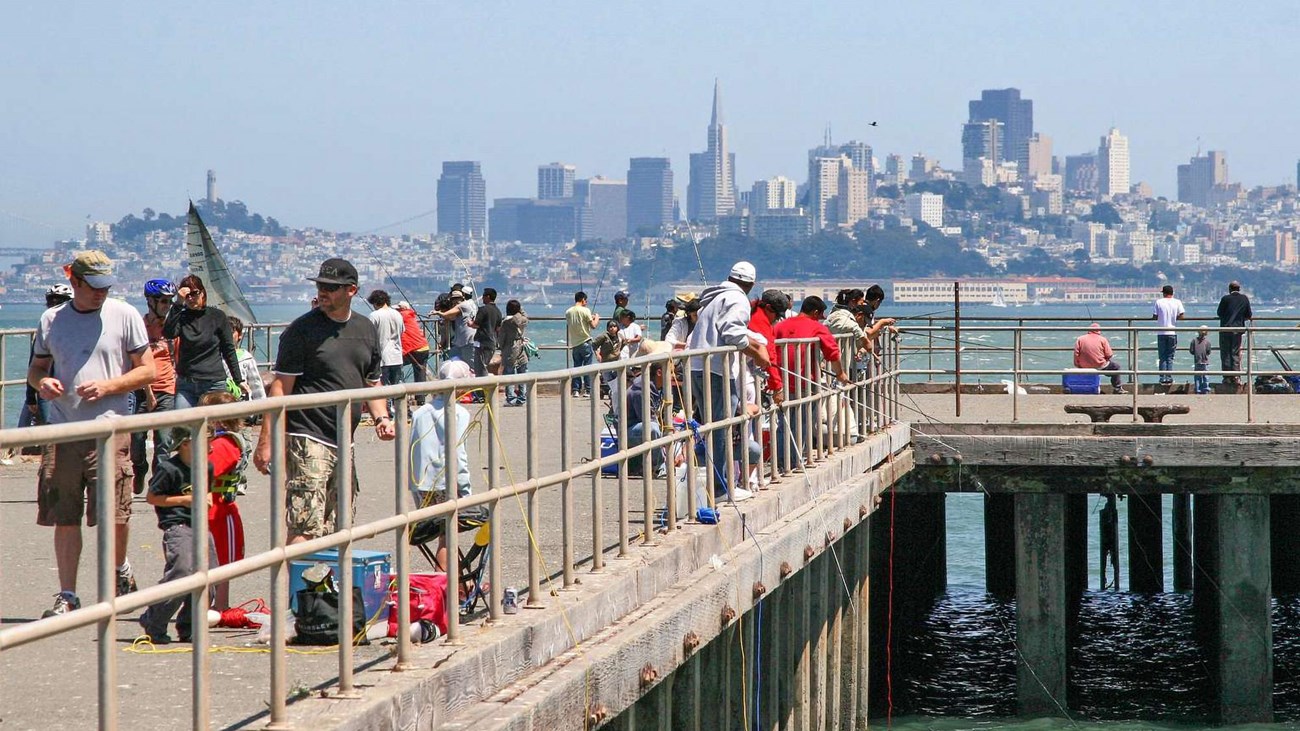Last updated: March 26, 2021
Thing to Do
Fort Baker Fishing

What comes to mind when you think about fishing? Patience, relaxation, challenge, and memories are a few words often associated with fishing. You will find all that and a sense of stewardship, conservation, and preservation on this page. We want you to have an enjoyable time during your visit, and for those who come after you to fish. Take some time to explore, learn what the park has to offer and learn your responsibilities before casting a line or flicking a fly into the water.
Golden Gate National Recreation Area allows fishing as a means of providing for public enjoyment, and customary and traditional use, and regulates fishing to ensure that it is managed in a manner that avoids unacceptable impacts to park resources.
The following regulations apply only within Golden Gate National Recreation Area
The following areas are open to recreational fishing and do not require fishing licenses:
Marin County
-
Fort Baker pier and jetty
San Francisco
-
Fort Mason Piers Two & Three (Herbst and Festival Pavilions)
-
Fort Point pier (a.k.a. Torpedo Wharf)
In accordance with California law, (Fish and Game Code § 7153 and Section 1.88 of Title 14 of the California Code of Regulations) public fishing piers and jetties, open 24 hours a day, do not require a state fishing license.
The following areas are closed to fishing:
Marin County
- Easkoot Creek, Stinson Beach
- Muir Woods National Monument (36 CFR 7.6)
- Redwood Creek (including Muir Beach Lagoon and tidewaters)
- Tennessee Valley Pond (next to the beach)
- Rodeo Lagoon, Marin Headlands
- Rodeo Lake, Marin Headlands
San Francisco
-
Alcatraz Island shoreline
-
Crissy Field Former Coast Guard Pier, breakwater and seawall
-
Lobos Creek, Presidio Area
The following are prohibited:
-
Fishing in fresh waters in any manner other than by hook and line, with the rod or line being closely attended.
-
Possessing or using as bait for fishing in freshwaters, live or dead minnows or other bait fish, amphibians, non-preserved fish eggs or fish roe, except in designated waters.
-
Chumming or placing preserved or fresh fish eggs, fish roe, food, fish parts, chemicals, or other foreign substances in fresh waters for the purpose of feeding or attracting fish in order that they may be taken.
-
Commercial fishing, except where specifically authorized by Federal statutory law.
-
Fishing by the use of drugs, poisons, explosives, or electricity.
-
Digging for bait, except in privately owned lands.
-
Failing to return carefully and immediately to the water from which it was taken a fish that does not meet size or species restrictions or that the person chooses not to keep. Fish so released shall not be included in the catch or possession limit: Provided, that at the time of catching the person did not possess the legal limit of fish.
-
Fishing from motor road bridges, from or within 200 feet of a public raft or float designated for water sports, or within the limits of locations designated as swimming beaches, surfing areas, or public boat docks, except in designated areas.
-
Introducing wildlife, fish or plants, including their reproductive bodies, into a park area ecosystem. This includes the discarding and/or dumping of bait and bait buckets.
-
The use or possession of fish, wildlife or plants for ceremonial or religious purposes, except where specifically authorized by Federal statutory law, or treaty rights. Except as otherwise designated, fishing with a net, spear, or weapon in the salt waters of park areas shall be in accordance with State law.
Fishing Throughout the National Park Service We invite you to visit the Fish and Fishing website for more information about fish and fishing in the National Park Service. You will learn about conservation, different fish species, and parks that offer fishing.
Licenses
A valid California fishing license is required to fish in the park although exceptions may apply, and fees vary. Children under 16 years of age do not require a license. Visitors fishing within Golden Gate National Recreation Area must follow the fishing license requirements in accordance with the laws and regulations of the California Department of Fish and Wildlife.
Fishing Regulations
Unless otherwise provided for, fishing regulations apply to all finfish found in both fresh and saltwater, and mollusks and crustaceans found in saltwater (shellfish). Other taxa, including amphibians, and freshwater mollusks and crustaceans (e.g. waterdogs, crayfish) are not considered “fish” for the purpose of NPS fishing regulations and are addressed by NPS regulations governing “wildlife” (36CFR2.2).
These fishing regulations apply, regardless of land ownership, on all lands and waters within the park that are under the legislative jurisdiction of the United States.
Fishing shall be in accordance with the laws and regulations of the State of California (36CFR2.3(a)) except as provided below. Where there is a conflict between a state regulation and a federal (NPS) regulation, the state regulation is superseded by the federal regulation.
For state fishing regulations please visit the California Department of Fish and Wildlife website.
For more information on how NPS fishing regulations work, go to the regulations page on the NPS Fish and Fishing website (https://www.nps.gov/subjects/fishing/how-regulations-work.htm).
Fishing on the public pier at Fort Baker does not require a fishing license.
In other areas of Golden Gate National Recreation Area, a valid California fishing license is required to fish in the park although exceptions may apply, and fees vary. Children under 16 years of age do not require a license. Visitors fishing within must follow the fishing license requirements in accordance with the laws and regulations of the California Department of Fish and Wildlife.
Fort Baker Accessible Features
- Accessible and Designated Accessible Parking Stalls
- Accessible Portable Toilet
- Accessible Overlooks
- Accessible Picnicking
- Usable Fishing Pier
- Accessible Cell Phone Tour
